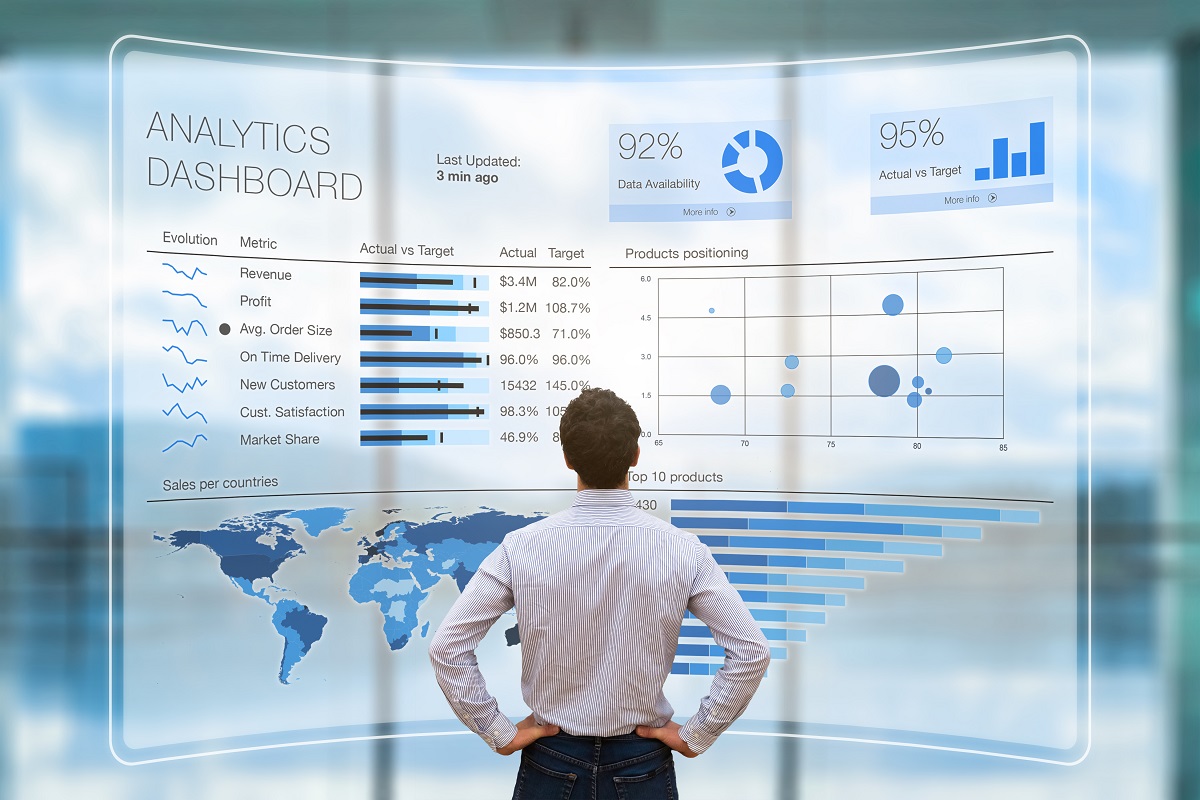Business Intelligence (BI) refers to the technologies, applications, and practices used to collect, integrate, analyze, and present business information. It’s a powerful tool supporting better business decision-making, providing a competitive edge over rivals.
BI tools can access and analyze data sets. They also present analytical findings in reports, graphs, summaries, charts, dashboards, and maps. The importance of BI cannot be overstated, as it provides actionable insights into business performance, aids in identifying market trends, boosts operational efficiency, and drives effective strategic planning.
Before diving into the future, it’s essential to acknowledge the evolution of business intelligence (BI). Initially, BI was primarily a privilege of large corporations with ample resources to maintain complex IT infrastructures. Early BI systems were focused mainly on historical analysis of operations and financial data, often needing to be more stable, inflexible, and needing real-time capabilities.
With the advent of the digital era, BI tools have undergone a series of transformations. They have evolved from traditional, on-premises solutions to more flexible, cloud-based systems, from IT-focused tools to more user-friendly, self-service applications. This democratization has enabled even small businesses to leverage BI’s power, providing unprecedented access to data-driven insights and decision-making capabilities.
Here are 13 key predictions for the future of business intelligence:
Prediction 1: AI-Driven BI Will Revolutionize Data Analysis
AI will revolutionize data analysis, with machine learning (ML) and natural language processing (NLP) powering advanced analytics and predictive capabilities. AI-driven BI systems will be able to identify patterns in data, spot anomalies, and suggest alternative courses of action.
Global giants like Amazon and Netflix are already leveraging the power of AI for business intelligence. Amazon uses AI-powered BI to enhance its recommendation engine, customer service, and inventory management. The system analyzes vast amounts of data to predict consumer behavior, improve product recommendations, and personalize user experience.
On the other hand, Netflix employs AI-driven BI to fine-tune its recommendation algorithm and optimize content creation. By analyzing viewer data, they can predict show popularity and viewer preferences, thus guiding investment in original content. These industry leaders are perfect examples of how AI will continue revolutionizing BI, making businesses more agile, customer-centric, and data-driven.
Statistics on the Efficiency and Accuracy of AI-Driven BI
Statistics demonstrate the impressive efficiency and accuracy of AI-driven BI systems. According to a Gartner report, by 2023, AI and deep-learning techniques are projected to be the most common approaches for new data science applications.
A study by Accenture revealed that AI could increase labor productivity by up to 40 percent and enable people to make more efficient use of their time. In terms of accuracy, McKinsey estimates that AI systems can reduce errors in business intelligence by as much as 50 percent. This increased accuracy can lead to more precise business decisions and improved operational efficiency.
Prediction 2: Increased Focus on Data Privacy and Security
As businesses rely on data-driven insights for decision-making and operational efficiency, more attention and resources will be devoted to protecting private customer information. As most BI solutions are cloud-based, stringent security measures must be taken to protect the data from potential cyber threats.
The European Union’s GDPR (General Data Protection Regulation) was created to ensure the security and privacy of personal data. It’s a set of rules which requires companies to manage customer data responsibly, meaning they must be transparent about how it is collected, stored, and shared. Companies must now adhere to the strict guidelines or face harsh penalties.
In addition to GDPR, organizations should proactively protect their data from potential cyber threats. This includes investing in advanced security technologies such as data encryption, authentication, and identity management for users and devices accessing the system.
The future of BI will be characterized by an increased focus on data privacy and security, requiring organizations to take extra measures to ensure their customer’s information is fully protected. With the risks posed by cyberattacks increasing over time, companies must prioritize data security.
Prediction 3: Integration of IoT and BI for Real-Time Insights

Integrating the Internet of Things (IoT) and business intelligence will open up a new realm of real-time insights. By leveraging the power of IoT, businesses can capture and analyze data from connected devices to make more informed decisions in near real-time.
This technology is already being employed by some industry giants like Walmart, which leverages IoT technology to collect data from a vast network of connected sensors across its stores. This enables Walmart to monitor sales trends, inventory levels, customer behavior, and store traffic in real-time, helping them better understand their customers and make smarter decisions.
In the future, more businesses will invest in integrating BI with IoT solutions. Organizations can gain more accurate insights into consumer behavior and market trends by collecting large amounts of data in near real-time. These insights can then be used to optimize operations, boost customer satisfaction, and increase sales.
Prediction 4: Democratization of BI Tools for Non-Tech Users
The democratization of BI tools will characterize the future of business intelligence. Non-tech users like sales and marketing professionals can access powerful data-driven insights in an easy-to-use platform.
This shift has already begun with the emergence of self-service BI solutions like Tableau, PowerBI, and Qlikview. These tools enable non-technical users to access and analyze data quickly with minimal training, removing the need for complex IT infrastructure or programming knowledge. This democratization makes it easier for organizations to empower every employee with data-driven insights, leading to more informed decisions and better business performance.
Moreover, these self-service BI solutions are often cloud-based, meaning they can be accessed from anywhere with an internet connection. This enables organizations to make decisions in near real-time and respond quickly to changing market conditions, providing a competitive edge over rivals.
Prediction 5: Mobile-First BI Solutions Will Gain Popularity
Given the ubiquity of smartphones, mobile-first BI solutions will gain popularity. Most users can now access business intelligence data on mobile devices like tablets and smartphones. This shift has created a demand for more sophisticated mobile applications optimized for small screens, enabling users to access information quickly and accurately.
Many BI vendors have developed mobile-based solutions with intuitive user interfaces and powerful data visualization capabilities in response to this trend. These apps enable users to access real-time insights on their mobile devices, allowing them to make informed decisions quickly and efficiently.
This shift towards mobile BI is crucial for organizations as it provides greater accessibility and flexibility in data-driven decision-making. As more users access data on the go, companies must invest in mobile-first solutions to stay competitive in today’s markets.
Prediction 6: Natural Language Processing (NLP) for Enhanced Data Querying
The advancement of Natural Language Processing (NLP) will significantly enhance data querying in business intelligence. Using NLP, BI tools can comprehend and respond to user queries in natural, everyday language, making data analysis more accessible and user-friendly.
For example, a user could ask the BI system, “What were the sales figures for the last quarter?” the system would provide a direct answer, making data navigation effortless. This is a significant shift from traditional querying methods, which often require a basic understanding of programming languages like SQL.
Applications of NLP in BI go beyond just simplifying queries. They also include sentiment analysis, text mining, and automated report writing. This saves time and enables users to focus on decision-making rather than on technical aspects of data analysis.
NLP’s integration into BI tools is a testament to the ongoing democratization of data. It’s a trend that will likely intensify, making BI systems even more intuitive, engaging, and user-friendly.
Prediction 7: BI will Play a Vital Role in Sustainability Efforts

Business intelligence will increasingly contribute to sustainability efforts, enabling businesses to monitor, manage, and reduce their environmental impact effectively. In real-time, organizations can use BI tools to track their energy use, waste production, and carbon emissions. These data-driven insights can help identify inefficiencies, benchmark performance against industry standards, and develop strategies to reduce environmental footprint.
Moreover, BI can aid in sustainable decision-making by visualizing the outcomes of different scenarios. For instance, organizations can compare the environmental and financial impacts of various supply chain configurations, production methods, or waste management strategies. This allows businesses to make informed decisions that balance profitability and sustainability.
Lastly, BI tools can assist in regulatory compliance by helping organizations track and report their sustainability metrics. As environmental regulations become stricter, businesses that can accurately and transparently report their environmental performance will have a competitive edge. Hence, as sustainability continues to gain importance in the business world, the role of BI in advancing these efforts will also grow.
Prediction 8: Hybrid BI models for improved scalability
Adopting hybrid business intelligence (BI) models is set to rise, paving the way for improved scalability. Hybrid BI models combine the best of both worlds: on-premises and cloud-based solutions. They allow businesses to store sensitive data in-house while capitalizing on the scalability and cost-effectiveness of cloud storage for less sensitive, voluminous data.
The benefits of hybrid BI models are numerous. Firstly, they are highly scalable, able to expand or contract resources as business needs change. This flexibility allows companies to grow without worrying about outgrowing their BI infrastructure.
Secondly, hybrid models provide redundancy and disaster recovery. If there’s a failure on the on-premises end, the cloud-based system ensures no data loss or downtime.
Lastly, hybrid BI models offer the security of on-premises solutions combined with the accessibility of the cloud. They allow businesses to maintain strict control and security over sensitive data while still benefiting from the accessibility and collaborative nature of cloud-based BI tools.
The future of business intelligence lies in hybrid models, which blend on-premises control with cloud flexibility, providing businesses with a secure, scalable, and cost-effective BI solution.
Prediction 9: Convergence of BI and Predictive Analytics
The future of business intelligence will see a convergence with predictive analytics. This fusion will enable businesses to understand and interpret past and present data and predict future trends. Predictive analytics utilizes statistical algorithms and machine learning techniques to analyze historical data and predict future outcomes.
The convergence of BI and predictive analytics offers businesses a more strategic approach to decision-making. For instance, a retail business can analyze historical sales data to predict future product demand, allowing them to adjust inventory levels accordingly. Predictive analytics can also anticipate customer behavior and identify opportunities for targeted marketing campaigns, helping organizations increase revenue and optimize operations.
The merger of BI and predictive analytics will give businesses unprecedented insights into the future, allowing them to make decisions more quickly and confidently. As such, it is a trend that will likely stay.
Prediction 10: AI-Generated Automated Insights for Proactive Decision-Making
The evolution of business intelligence will witness an upsurge of AI-generated automated insights, fostering a proactive decision-making culture within organizations. AI algorithms will sift through vast amounts of data, identifying patterns, trends, and anomalies that might go unnoticed by the human eye. They will then generate actionable insights and present them to decision-makers in an easily digestible format, such as intuitive dashboards or succinct reports.
Beyond just identifying trends, AI can also suggest recommended actions based on the insights generated. For instance, if the AI detects a sudden drop in sales for a particular product, it might suggest a targeted promotional campaign to boost sales or investigate possible product issues.
This capability of AI to deliver proactive, actionable insights without human intervention can significantly improve business agility. Organizations can react promptly to changes in the market environment, seize opportunities more quickly, and mitigate potential risks before they escalate.
Embracing AI-generated automated insights will accelerate the decision-making process and enhance the accuracy of business decisions. Integrating AI into BI systems will revolutionize how businesses operate as society strides into the future, making proactive decision-making a new norm.
Prediction 11: Personalization in BI Dashboards and Reporting

One significant transformation people can anticipate in the future of business intelligence is the increased personalization of BI dashboards and reporting. As businesses become more complex and data-driven, the need for personalized, role-based dashboards and reports escalates.
Personalization in BI tools means tailoring interfaces, dashboards, and reports to meet the needs of individual users or user groups. For instance, a marketing professional might need a dashboard focused on campaign performance and customer demographics. At the same time, a financial analyst might require a dashboard centered around revenue, costs, and profit margins.
With personalized dashboards, users can focus on the most relevant information for their role, improving efficiency and productivity. Personalization also extends to reporting, with the ability to customize reports’ format, data, and delivery method based on individual preferences and requirements.
Moreover, AI-driven personalization can provide predictive insights tailored to individual roles, making decision-making more accurate and efficient. Personalizing BI dashboards and reporting will be a game-changer as the world moves toward the future, allowing businesses to leverage data more effectively to meet their unique goals and challenges.
Prediction 12: Visualization Advancements for Clearer Data Representation
As the future of business intelligence unfolds, advancements in data visualization techniques will play a crucial role in providing clearer, more effective data representation. Sophisticated visualization tools will transform complex datasets into intuitive, easy-to-understand visual formats, allowing for rapid interpretation and analysis.
Integrating 3D visualization, interactive dashboards, and real-time data feeds will offer users a more immersive, dynamic experience, making data exploration more engaging and informative. This includes manipulating visual data, drilling into specific points, and viewing data in real-time.
Furthermore, AI and machine learning technologies will play a significant role in advancing data visualization. They will enable the automatic generation of visualizations based on the data’s characteristics and the user’s objectives, simplifying the process of creating meaningful and compelling visual displays of data.
These advancements in data visualization will make complex data more accessible and understandable, facilitating data-driven decision-making across all levels of an organization. As a result, organizations can derive more value from their data assets and make more informed, strategic business decisions.
Prediction 13: BI will be Integrated into Everyday Applications
The future of Business Intelligence (BI) comes with the promise of becoming increasingly ingrained into everyday applications. As the lines between business and personal data blur, a rising trend of BI tools will be incorporated into commonly used applications such as email clients, productivity apps, and even social media platforms.
For instance, imagine receiving AI-driven, real-time analytics about your email habits directly within your email client, helping you to boost your productivity. Or consider a social platform that offers insights into your post’s performance, audience engagement, and other useful metrics, all powered by BI.
This integration will make data analytics part of your daily life, prompting more informed decisions in business and personal contexts. By streamlining access to data analytics, BI will move away from a specialized field and become a ubiquitous part of living in the digital age. Business intelligence is expected to open new avenues for personal growth and productivity, marking a significant step in the democratization of data.
Conclusion
The future of business intelligence (BI) is filled with exciting possibilities that are set to transform the way businesses operate. Advancements in technologies like AI and NLP, coupled with the convergence of predictive analytics and BI, promise a future of proactive decision-making, where businesses can anticipate trends and make strategic decisions based on concrete data. Hybrid BI models will offer scalability and security, while personalization in BI dashboards and reporting will foster effective data utilization tailored to individual roles. Furthermore, integrating BI into everyday applications is set to democratize data analytics, making it an integral part of business and personal life. With these developments, BI is poised to become more accessible, intuitive, and powerful, guiding the world toward a future where data-driven insights are at the heart of decision-making.

